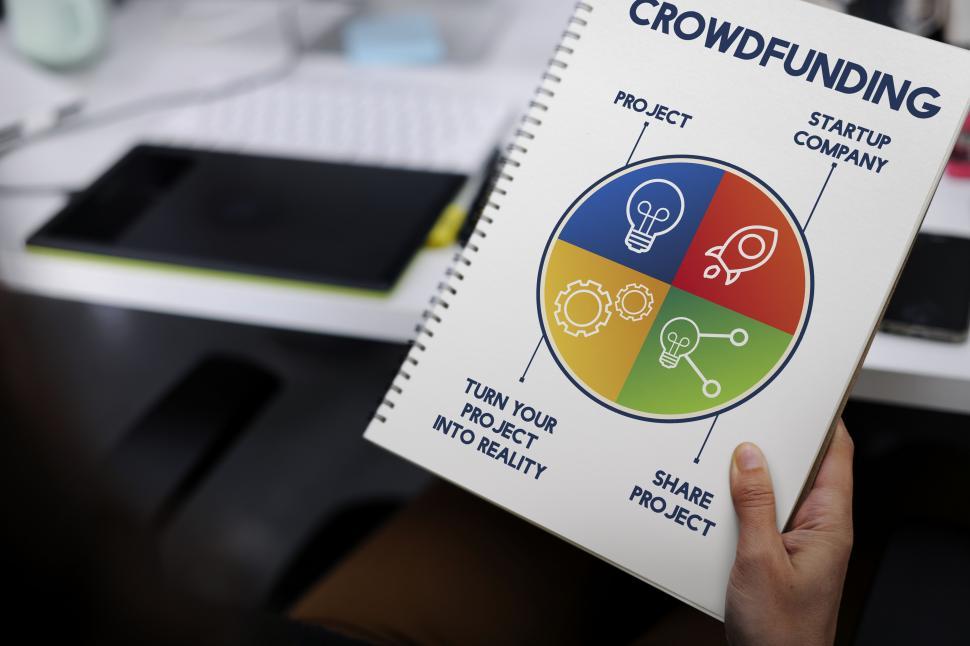An in-depth, research-based guide for entrepreneurs exploring modern funding solutions in 2025.
Starting a business is an exciting yet daunting journey. One of the biggest hurdles entrepreneurs face is securing enough capital to turn their ideas into reality. In recent years, crowdfunding has emerged as one of the most accessible and empowering ways to raise funds—offering startups a chance to validate ideas, engage communities, and secure early financial support without traditional investors.
But is crowdfunding the right choice for your startup? This long-form SEO-optimized guide explores how crowdfunding works, its benefits and drawbacks, and what you need to know before launching your campaign. Backed by scientific insights and real-world examples, it provides a clear roadmap to help you decide whether this funding path aligns with your business goals.
🚀 What Is Crowdfunding?
Crowdfunding is the process of raising small amounts of money from a large number of people—typically via online platforms—to fund a business, project, or idea. Instead of relying on banks, venture capitalists, or angel investors, entrepreneurs can directly reach out to potential supporters and customers through crowdfunding websites.
Popular platforms include:
- Kickstarter
- Indiegogo
- GoFundMe
- SeedInvest
- Republic
- Crowdcube
- StartEngine
💡 According to the University of Cambridge Centre for Alternative Finance, crowdfunding has grown into a $17 billion global industry, with the U.S. leading in both equity and reward-based crowdfunding campaigns.
💼 How Crowdfunding Works
The crowdfunding model is simple yet powerful:
- An entrepreneur presents a campaign detailing their idea, funding goal, and what contributors receive in return.
- Backers (individuals or investors) pledge money through the platform.
- Once the funding goal is reached, the funds are released to the creator (depending on platform rules).
- The startup uses the funds to build, launch, or scale its product.
Each campaign runs for a limited time—typically between 30 to 60 days—creating urgency and excitement among potential backers.
📊 Types of Crowdfunding
Crowdfunding is not one-size-fits-all. Understanding the four main types will help you determine which model best fits your business goals.
| Type | Description | Best For | Example Platforms |
|---|---|---|---|
| Reward-Based | Backers contribute in exchange for a product or perk. | Product launches, creative projects | Kickstarter, Indiegogo |
| Equity Crowdfunding | Investors receive shares or equity in the company. | Startups seeking long-term growth | SeedInvest, StartEngine |
| Donation-Based | People donate with no expectation of return. | Social causes, community projects | GoFundMe |
| Debt-Based (Peer-to-Peer Lending) | Borrowers repay funds with interest. | Small businesses needing capital | LendingClub, Funding Circle |
📚 Research Insight: A 2023 study by Harvard Business School found that startups using reward-based crowdfunding are 30% more likely to secure venture capital funding later, as successful campaigns signal strong market demand.
💡 The Appeal of Crowdfunding for Startups
For many entrepreneurs, crowdfunding is more than just a financial tool—it’s a way to build a community around their vision. Here’s why it’s so attractive:
1. Access to Capital Without Debt
Unlike traditional loans, crowdfunding doesn’t always require repayment (depending on the model). You can raise funds without giving away full control or equity unless you choose an equity-based model.
2. Market Validation
Before launching full-scale production, a successful campaign demonstrates that there’s real demand for your idea. It’s like getting paid to test your concept.
3. Community and Brand Building
Crowdfunding turns early supporters into brand advocates. They feel emotionally invested in your success, helping to amplify your marketing reach.
4. Media and Investor Attention
Popular campaigns often attract media coverage and interest from angel investors or VCs looking for the next big thing.
5. Low Entry Barriers
Most platforms require only a compelling campaign page, a prototype or concept, and a clear story. There are no complex financial hoops to jump through like traditional funding routes.
⚠️ The Downsides of Crowdfunding
While crowdfunding offers great opportunities, it’s not without risk. Many campaigns fail to reach their goals or encounter post-funding challenges.
1. High Competition
With thousands of new campaigns launched every week, standing out requires professional storytelling, marketing, and design.
2. Time and Effort Intensive
Creating a successful campaign involves weeks or months of preparation, video production, content creation, and constant promotion.
3. Fulfillment Challenges
For reward-based crowdfunding, managing production and delivery can be overwhelming, especially for first-time founders.
4. Platform Fees
Most platforms take a 5–8% commission of the funds raised, plus payment processing fees.
5. Public Failure
Unsuccessful campaigns are visible online, which can discourage potential investors later.
🔬 Study Note: According to the University of California, Berkeley, only about 37% of crowdfunding campaigns reach their funding goals. However, campaigns with strong storytelling, visuals, and early traction are 4x more likely to succeed.
🧭 Is Crowdfunding Right for You?
To determine if crowdfunding aligns with your business, ask yourself the following questions:
| Question | Why It Matters |
|---|---|
| Do you have a compelling story or product? | Emotional appeal drives crowdfunding success. |
| Can you offer tangible rewards or incentives? | Increases backer engagement and trust. |
| Are you ready to promote your campaign aggressively? | Marketing determines 70% of campaign outcomes. |
| Do you have a prototype or working model? | Demonstrates credibility to potential backers. |
| Can you fulfill orders or promises efficiently? | Post-campaign logistics can make or break your reputation. |
If you answered “yes” to most of these, crowdfunding could be an excellent path for your startup.
💬 Real-World Success Stories
These real-world examples illustrate how crowdfunding can propel startups to success:
1. Pebble Smartwatch
Raised $20 million on Kickstarter—one of the largest campaigns ever. Pebble used crowdfunding to prove demand before producing at scale, paving the way for the wearable tech boom.
2. Oculus Rift
Started with a $2.4 million Kickstarter campaign before being acquired by Facebook for $2 billion. Crowdfunding validated its concept to investors.
3. Exploding Kittens (Card Game)
Raised $8.7 million from 219,000 backers, showing that humor and creativity can dominate even non-tech categories.
4. Flow Hive (Beekeeping Innovation)
Raised $14 million through storytelling and clear problem-solving for beekeepers worldwide.
🧠 Insight: According to MIT Sloan School of Management, successful crowdfunding campaigns often tap into psychological factors like social proof, storytelling, and shared identity to create emotional resonance with backers.
🧩 How to Launch a Successful Crowdfunding Campaign
Launching a campaign requires more than a good idea—it’s about strategy, preparation, and execution. Follow these steps to maximize your chances of success.
Step 1: Research and Choose the Right Platform
Each platform caters to different audiences and funding models. Research competitors and success rates before selecting your platform.
Step 2: Set a Realistic Funding Goal
Aim for a target you can achieve while covering essential startup costs. Most successful campaigns fall between $10,000–$50,000.
Step 3: Create a Compelling Story
Your story is your biggest selling point. Include:
- Why you started the business
- The problem you’re solving
- How your product changes lives
🎥 Tip: Campaigns with high-quality videos raise 105% more funds on average, according to Crowdfund Insider Research.
Step 4: Offer Attractive Rewards
If you’re using reward-based crowdfunding, make perks meaningful and tiered:
- Early-bird pricing
- Limited-edition versions
- Behind-the-scenes experiences
Step 5: Build an Audience Before Launch
Promote your campaign 2–3 months before launch via:
- Email newsletters
- Social media
- Press outreach
- Influencer partnerships
Step 6: Maintain Engagement During Campaign
Keep backers informed with regular updates, stretch goals, and personal thank-yous. Engagement builds trust and drives momentum.
Step 7: Plan for Fulfillment and Post-Campaign Management
After funding, deliver on promises quickly. Poor fulfillment can damage your brand and future business opportunities.
📈 Crowdfunding vs. Other Funding Methods
| Funding Source | Equity Required | Speed | Community Engagement | Risk | Ideal For |
|---|---|---|---|---|---|
| Crowdfunding | Optional | Fast | High | Moderate | Early-stage startups |
| Venture Capital | Yes | Slow | Low | High | Scalable tech startups |
| Bank Loans | No | Moderate | None | Financial risk | Established businesses |
| Angel Investors | Yes | Slow | Low | Medium | Innovative startups |
| Bootstrapping | No | Slow | Full control | High personal risk | Founders with savings |
📚 Scientific Research on Crowdfunding Psychology
Recent research highlights how psychology and social behavior play key roles in crowdfunding success.
- Stanford University found that campaigns using emotionally engaging language were 35% more successful than purely technical ones.
- University of Cambridge discovered that campaigns reaching 30% of their goal within the first week have a 90% chance of success due to social momentum.
- Wharton School of Business research shows that transparency and frequent updates significantly improve investor trust and retention.
These studies suggest that crowdfunding isn’t just financial—it’s deeply social and psychological.
🧠 Common Mistakes to Avoid
Avoiding these pitfalls can make the difference between success and failure:
- Launching without a pre-built audience
- Overpromising rewards you can’t deliver
- Poor campaign visuals or unclear messaging
- Ignoring post-launch communication
- Setting unrealistic timelines or goals
🧩 Pro tip: Create a mock campaign and test it with friends, mentors, or small focus groups before going live.
💬 FAQs About Crowdfunding Your Startup
Q1: How much does it cost to start a crowdfunding campaign?
A: Most platforms charge around 5% in fees, plus 2–3% for payment processing. Additional costs may include video production and marketing.
Q2: Can I run multiple crowdfunding campaigns?
A: Yes, though it’s best to focus on one at a time. Many brands use a second campaign to launch upgraded versions of successful products.
Q3: What if my campaign fails?
A: You can re-strategize and relaunch. Analyze your feedback, adjust your pitch, and rebuild your audience. Many successful campaigns succeed on the second try.
Q4: Do I need a company before crowdfunding?
A: Not always. You can launch as an individual on many platforms, but forming an LLC or corporation helps with credibility and fulfillment logistics.
Q5: How do equity crowdfunding regulations work in the U.S.?
A: The JOBS Act allows startups to raise up to $5 million annually through approved portals like Republic or SeedInvest, with clear disclosure requirements.
Q6: How long should a campaign last?
A: The sweet spot is 30 to 45 days. Longer campaigns tend to lose momentum and engagement.
Q7: What makes a campaign trustworthy?
A: Transparency, a working prototype, credible team members, and consistent communication build confidence among backers.



